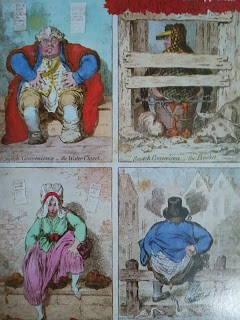 |
| peeing a pedestrian was not rare some centuries ago |
Nowadays hygiene is something fundamental.Many people expect to find their cities clean and they do the most to keep themselves clean too. Being neat is a must in the western society, but was it always like this? Did we always use the same method to keep ourselves clean?
Let's go in the 16th and 17th century. At that time people believed that water could enter the body and that made it automatically unhealthy.Precisely they believed that hot water was allowing the entrance of unhealthy "air" which could damage the human organs.
Therefore with water out of the options people at this era relied on dry cleaning methods. The nobles were rubbing their face with handkerchiefs containing perfume.In the 16th century savoir vivre replaced the hygienologists. Bath continued to be an uknown word and instead the guides were giving alternative proposals like rubbing a roller with perfume on our armpit if it smelled like a goat.Hair cleaning included removal of grease with powder without using water.
About the body they were not doing anything. The whiteness of someone's clothes indicated his social status. Thus everyone was struggling to keep their clothes clean instead of their body.There were examples like the one of a French baron called Sobeur who was changing his shirt and collar every day while he was changing his underwear every four weeks. Of course the poor people couldn't even clean their clothes cause they didn't have other clothes than the ones they wore.
The immoral baths
In Byzantium the public baths were part of daily life. They were organised in guilds and offered comforts like steam bath , wine , food and resting places.In the 15th century a private bath was part of the parties of the rich people.The dukes were combining official dinners into private baths.But as we aforementioned since the 16th century all this changed. For instance the baths of Versailles constructed by Louis XIV ended up as residence of the count of Toulouse. At this time baths were associated with immoral acts and were and example of social corruption. In England baths were were forbidden since the 15th century from a decree by Henry the 5th.
Exactly the opposite was happening in the east. The Byzantine tradition of the baths survived in the Ottoman empire with the hamams or more popularly known today as Turkish baths.Meanwhile in the west even doctors like the French royal physician De Laurence who denounced bathing rendering water as the cause of all body malfunctions. Even Roger Bacon was suggesting that people should wash themselves using substances similar to the human flesh and body.All these suggestions influenced the society and nobles of the 17th century were having a bath once every five months. Bath was only allowed for medicinal occasions. The notorious Sun king Louis XIV took a bath twice after suggestions of his physicians and stated that he didn't want live that painful experience.Only in the second half of the 20th century the idea of bathing as a habbit of the rich spread. However the association of bathing with hygiene was still something unknown.
Dirty cities
 |
| There were no private toilets 300 tears ago. Thus people were doing it everywhere |
Sewers in the cities were introduced in the 19th century. Before that the cities were a mess. The garbage and crap were smelling everywhere and the nobles were moving in the cities with coaches. When they had to walk they were wearing high boots in order to avoid the dirty waters.In the German city of Ulm they were even using stilts. The authorities tried to improve the situation by putting fines on those who threw their garbage on the streets but it was ineffective.It's interesting to mention that one of the first cleaning methods was to unleash pigs which would eat all the garbage.
Toilet? What's a toilet?
 |
| Workers had to collect all the crap from the streets. It was a really dirty job. |
Since the ancient times there were sewers in the cities. However we know that even organised cities like Byzantine Constantinople had serious problems with crap.In the medieval era people didn't have private toilets.Thus people were polluting the streets and public toilets were a source of all diseases.People were building small rooms with holes in order to have something similar to a private toilet. Boccaccio in The Decameron he mentions an incident where somebody fell on the wooden walls of a ready to collapse toilet and was mocked by everyone around.
No comments:
Post a Comment